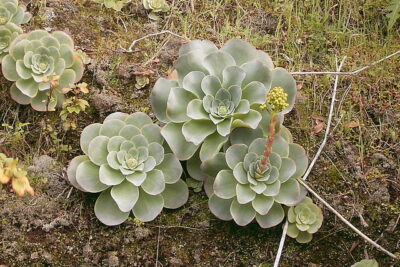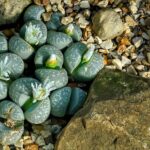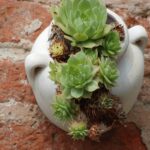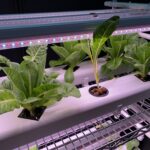
Choosing Low-Light Succulents: A Guide to Thriving Indoors

Succulents have gained immense popularity in recent years, with their unique and eye-catching shapes, vibrant colors, and ability to thrive in dry conditions. However, many succulents are known for their preference for bright sunlight, making it challenging for indoor gardeners with limited access to natural light to grow them successfully. Thankfully, there are a variety of low-light succulents available that are well-suited for indoor environments, allowing even those with darker spaces to enjoy the beauty and benefits of these plants.
We will explore the world of low-light succulents and provide a comprehensive guide to help you choose the right ones for your indoor garden. We will discuss the specific characteristics and requirements of low-light succulents, including their tolerance for shade, their water and soil needs, and their growth habits. Additionally, we will provide recommendations for the best low-light succulents to consider, along with tips for their care and maintenance. Whether you are a seasoned succulent enthusiast or a beginner looking to bring some greenery into your home, this guide will equip you with the knowledge and tools to create a thriving indoor succulent garden.
- Research different types of low-light succulents and their specific light requirements
- Look for succulents that are known to thrive in low-light conditions
- Consider placing succulents near windows or in areas with indirect sunlight
- Use grow lights to supplement the natural light and provide the necessary light spectrum for succulents
- Ensure proper watering by allowing the soil to dry out completely between waterings
- Use a well-draining soil mix specifically formulated for succulents
- Avoid overwatering and root rot by using pots with drainage holes
- Monitor humidity levels and provide adequate air circulation to prevent moisture-related issues
- Apply a balanced fertilizer sparingly during the growing season to provide essential nutrients
- Regularly inspect and remove any dead or damaged leaves to promote healthy growth
- Rotate succulents periodically to ensure even light exposure and prevent stretching
- Keep an eye out for signs of stress or sunburn and adjust lighting accordingly
- Frequently Asked Questions
Research different types of low-light succulents and their specific light requirements
When it comes to choosing low-light succulents for your indoor space, it's important to understand the specific light requirements of each type. While most succulents thrive in bright, direct sunlight, there are certain varieties that can tolerate lower light conditions. Researching and familiarizing yourself with these types will help you make informed decisions and ensure the success of your indoor succulent garden.
Here are some popular low-light succulents to consider:
- Sansevieria (Snake Plant): This succulent is known for its ability to thrive in low-light conditions. It can tolerate a wide range of light levels, making it a perfect choice for indoor spaces with limited sunlight.
- Zamioculcas zamiifolia (ZZ Plant): The ZZ Plant is another excellent option for low-light environments. It can adapt to various light conditions, including low-light settings, and requires minimal care.
- Haworthia: Known for its attractive rosette-shaped leaves, Haworthia is a low-light succulent that can be grown indoors with ease. It prefers indirect light and can even thrive under fluorescent lighting.
- Gasteria: Gasteria is a versatile succulent that can tolerate low-light conditions. It features thick, fleshy leaves and can add a unique touch to your indoor succulent display.
It's important to note that while these succulents can tolerate lower light levels, they still require some amount of light to thrive. Placing them near a window where they can receive indirect sunlight for a few hours a day is ideal. Avoid placing them in areas with no natural light or in dimly lit corners.
Remember, even low-light succulents need some care and attention. Regularly check the soil moisture levels and water accordingly, making sure not to overwater them. Additionally, provide adequate airflow and ensure the plants are not placed in excessively humid environments to prevent rot and fungal issues.
 Growing Aloe Vera Indoors: Tips for Cultivating Succulent Houseplants
Growing Aloe Vera Indoors: Tips for Cultivating Succulent HouseplantsBy researching different low-light succulents and understanding their light requirements, you can create a thriving indoor succulent garden that brings life and beauty to your home or office space.
Look for succulents that are known to thrive in low-light conditions
When it comes to selecting succulents for indoor spaces with limited natural light, it's essential to choose varieties that are well-suited for low-light conditions. While most succulents prefer bright and direct sunlight, there are certain species that can adapt and thrive in lower light levels.
To ensure the success of your indoor succulent garden, consider opting for the following low-light tolerant succulents:
- Sansevieria (Snake Plant): Snake plants are renowned for their ability to thrive in low-light environments. With their upright, sword-like leaves, they can add a touch of elegance to any indoor space.
- Zamioculcas zamiifolia (ZZ Plant): ZZ plants are incredibly resilient and can tolerate a wide range of lighting conditions, including low-light areas. Their glossy, dark green leaves make them a popular choice among indoor gardeners.
- Haworthia: Haworthias are small succulents with unique rosette-shaped leaves. They are well-suited for low-light conditions and can even tolerate fluorescent lighting, making them an ideal choice for offices or rooms with limited natural light.
- Gasteria: Gasterias are similar to Haworthias in terms of their low-light tolerance. These succulents have thick, fleshy leaves with interesting patterns and textures, making them visually appealing additions to any indoor garden.
Remember, even low-light tolerant succulents still require some amount of light to thrive. While they can survive in areas with less natural light, it's important to provide them with indirect or filtered sunlight whenever possible. Placing them near a north-facing window or using artificial grow lights can help supplement their lighting needs.
By choosing low-light succulents that are known to adapt well indoors, you can create a beautiful and thriving succulent garden even in spaces with limited natural light.
Consider placing succulents near windows or in areas with indirect sunlight
If you're looking to add some greenery to your indoor space but lack direct sunlight, low-light succulents may be the perfect option for you. These plants have adapted to thrive in environments with limited natural light, making them an excellent choice for indoor gardens, offices, or any room that lacks direct sunlight.
 Can You Successfully Grow Lotus Lithops Succulents Indoors?
Can You Successfully Grow Lotus Lithops Succulents Indoors?When selecting low-light succulents, it's important to consider their placement. Although they can tolerate low light conditions, they still require some indirect sunlight to survive. Placing them near windows or in areas that receive bright, indirect light is ideal for their growth. Remember to avoid exposing them to direct sunlight for extended periods, as it can lead to sunburn or damage their leaves.
Benefits of low-light succulents
Low maintenance: These plants require minimal care and attention, making them perfect for those with busy schedules or beginners in gardening.
Aesthetic appeal: With their diverse shapes, textures, and colors, low-light succulents can add a touch of beauty and elegance to any indoor space.
Air purification: Like other plants, low-light succulents can help improve the air quality in your home by absorbing toxins and releasing oxygen.
Stress relief: Research has shown that being around plants can reduce stress levels and improve overall well-being. Having low-light succulents in your indoor space can contribute to a calming and relaxing atmosphere.
Popular low-light succulent varieties
Here are some popular low-light succulent varieties that you can consider for your indoor garden:
- Snake Plant (Sansevieria): Known for its upright, sword-shaped leaves, the snake plant is a hardy succulent that can tolerate low-light conditions.
- Zebra Plant (Haworthia fasciata): With its striking white stripes on dark green leaves, the zebra plant is a visually appealing choice for low-light environments.
- Panda Plant (Kalanchoe tomentosa): This succulent features fuzzy, gray-green leaves with brown spots, giving it a unique and adorable appearance.
- Christmas Cactus (Schlumbergera): Known for its vibrant blooms during the holiday season, the Christmas cactus can thrive in low-light conditions as long as it receives some indirect sunlight.
Remember to research each plant's specific care requirements to ensure their well-being and longevity in your indoor space. With proper placement and care, low-light succulents can bring life and beauty to any room, even without direct sunlight.
 Can You Keep Succulents Indoors Year-Round?
Can You Keep Succulents Indoors Year-Round?Use grow lights to supplement the natural light and provide the necessary light spectrum for succulents
Succulents are known for their ability to thrive in bright, sunny conditions. However, not all of us have access to ample natural light indoors. If you're a succulent enthusiast with limited sunlight, don't worry! You can still enjoy a thriving indoor succulent garden by using grow lights to supplement the light your plants receive.
Grow lights are artificial light sources specifically designed to imitate the natural spectrum of sunlight. They provide the necessary light wavelengths for photosynthesis, allowing your succulents to grow and thrive even in low-light conditions. When choosing grow lights for your indoor succulents, there are a few factors to consider:
1. Light Spectrum
Succulents require a specific light spectrum to carry out photosynthesis effectively. The two key light wavelengths are blue light (400-500nm) and red light (600-700nm). Blue light promotes compact growth and enhances leaf coloration, while red light stimulates flowering and overall plant growth.
When selecting grow lights, look for options that provide a balanced spectrum of both blue and red light. Full-spectrum LED grow lights are an excellent choice as they emit light in the right wavelengths for succulent growth.
2. Light Intensity
The intensity of light is measured in foot-candles or lux. Succulents typically require moderate to high light intensity for optimal growth. However, in low-light conditions, it's essential to provide supplemental light to compensate for the lack of natural sunlight.
Choose grow lights with adjustable intensity settings to customize the light levels based on the specific needs of your succulents. This way, you can provide the right amount of light without overwhelming or damaging your plants.
 Indoor vs Outdoor: Ideal Growing Environments for Succulents
Indoor vs Outdoor: Ideal Growing Environments for Succulents3. Light Duration
Succulents, like most plants, require a specific duration of light exposure to carry out photosynthesis and maintain their growth cycle. On average, succulents need around 12-16 hours of light per day.
Invest in grow lights with built-in timers or use a separate timer to ensure your succulents receive the right amount of light each day. Timers can help automate the light cycle, allowing your plants to thrive without the need for constant manual adjustments.
4. Positioning of Grow Lights
Proper positioning of grow lights is crucial to ensure uniform light distribution and prevent leggy growth or etiolation. Place the lights close to your succulents, ideally around 6-12 inches above the plants.
Consider using adjustable light fixtures or hanging systems to maintain the ideal distance between the grow lights and your succulents. Regularly monitor your plants for signs of light stress, such as elongated stems or pale leaves, and adjust the positioning accordingly.
By using grow lights to supplement the natural light in your indoor space, you can create a suitable environment for your low-light succulents to thrive. Remember to choose grow lights with the right spectrum, intensity, and duration, and position them correctly to provide optimal growing conditions for your beloved succulents.
Ensure proper watering by allowing the soil to dry out completely between waterings
Proper watering is essential for the health and longevity of your low-light succulents. Succulents are known for their ability to store water in their leaves and stems, which allows them to thrive in arid conditions. However, overwatering can lead to root rot and other problems.
 Optimal Indoor Lighting for Succulents: Sunlight or Not?
Optimal Indoor Lighting for Succulents: Sunlight or Not?To prevent overwatering, it is crucial to allow the soil to dry out completely between waterings. This means waiting until the top inch of soil feels dry to the touch before watering again. Over time, you will develop a sense of when your succulents need water based on the moisture level of the soil.
Pro tip: Use a well-draining soil mix specifically formulated for succulents to further prevent waterlogging. This type of soil allows excess water to drain away quickly, reducing the risk of root rot.
Use a well-draining soil mix specifically formulated for succulents
When it comes to choosing low-light succulents for indoor spaces, one of the most important factors to consider is the soil. Succulents thrive in well-draining soil that allows excess water to escape, preventing root rot. It is essential to use a soil mix specifically formulated for succulents, as it provides the right balance of moisture retention and drainage.
A good succulent soil mix typically consists of a combination of materials such as coarse sand, perlite, pumice, and a small amount of organic matter. These components help create air pockets within the soil, allowing the roots to breathe and preventing waterlogged conditions.
When purchasing a pre-made succulent soil mix, look for products that are labeled as "fast-draining" or "specially formulated for succulents." Alternatively, you can create your own mix by combining equal parts of potting soil, perlite, and coarse sand.
Remember, using the right soil mix is crucial for the overall health and growth of your low-light succulents. It provides a solid foundation for proper water drainage and prevents the risk of overwatering, which can be detrimental to these plants.
 Can Succulents Thrive Indoors Without Sunlight?
Can Succulents Thrive Indoors Without Sunlight?Avoid overwatering and root rot by using pots with drainage holes
When it comes to choosing low-light succulents for indoor spaces, one crucial factor to consider is proper drainage. Succulents, known for their ability to store water in their leaves and stems, are particularly vulnerable to overwatering. To ensure the health and longevity of your indoor succulents, it's essential to use pots with drainage holes.
Drainage holes allow excess water to escape from the pot, preventing water from pooling at the bottom and causing root rot. This is especially important for low-light succulents, as they already receive less sunlight and have a slower growth rate. Without proper drainage, the soil can become waterlogged, leading to root rot and the eventual demise of your beloved plants.
When shopping for pots, look for containers that have multiple drainage holes. These holes should be large enough to allow water to flow freely but not so big that soil escapes. Additionally, it's advisable to choose pots made of porous materials, such as clay or terracotta, as they allow for better airflow and water evaporation.
Remember to place a saucer or tray beneath the pot to catch any excess water that drains out. This prevents water from damaging your furniture or floors while still allowing the roots to get the necessary moisture.
By selecting pots with proper drainage holes, you'll be providing your low-light succulents with the ideal growing conditions, reducing the risk of overwatering and ensuring their long-term thriving indoors.
When it comes to choosing low-light succulents to thrive indoors, there are a few important factors to consider. One of the most crucial aspects is monitoring humidity levels and providing adequate air circulation to prevent moisture-related issues.
 Can Succulents Flourish with Grow Lights?
Can Succulents Flourish with Grow Lights?Low-light succulents are generally more sensitive to excess moisture compared to their sun-loving counterparts. Therefore, it is essential to maintain a well-ventilated environment to avoid the risk of root rot and other fungal diseases.
To monitor humidity levels, you can invest in a hygrometer, a handy device that measures the moisture content in the air. Aim for a humidity range between 40% and 60% for optimal growth and health of your low-light succulents.
In addition to monitoring humidity, adequate air circulation is crucial for the well-being of your indoor succulents. Stagnant air can lead to a buildup of moisture around the plants, increasing the risk of fungal diseases. To promote air circulation, you can place a small fan near your succulent collection or open windows to allow a gentle breeze to flow through the room.
Here are some tips to provide adequate air circulation for your low-light succulents:
- Position your succulents away from corners or tight spaces where air may not circulate freely.
- Space out your plants to avoid overcrowding, allowing air to flow around each plant.
- Consider using a small oscillating fan to simulate natural wind movement indoors.
- Ensure that the room is well-ventilated by opening windows or using exhaust fans.
By monitoring humidity levels and providing adequate air circulation, you can create an ideal environment for your low-light succulents to thrive indoors. These simple steps will help prevent moisture-related issues and ensure the long-term health and beauty of your indoor succulent collection.
Apply a balanced fertilizer sparingly during the growing season to provide essential nutrients
When it comes to keeping your low-light succulents thriving indoors, providing them with the right nutrients is crucial. While these plants are known for their ability to survive in less-than-ideal lighting conditions, they still require proper nourishment to stay healthy.
 Can Mother of Thousands Succulents Thrive Indoors?
Can Mother of Thousands Succulents Thrive Indoors?One way to ensure your low-light succulents receive the nutrients they need is by applying a balanced fertilizer during the growing season. A balanced fertilizer contains a mix of essential nutrients like nitrogen, phosphorus, and potassium, which are necessary for the growth and development of plants.
When using a fertilizer, it's important to apply it sparingly. Over-fertilizing can lead to nutrient burn, damaging the roots and overall health of your succulents. Remember, these plants are adapted to survive in nutrient-poor environments, so they don't require as much fertilizer as other houseplants.
To apply the fertilizer, dilute it according to the instructions on the packaging. Generally, a half-strength solution is sufficient for low-light succulents. Use a watering can or spray bottle to evenly distribute the diluted fertilizer onto the soil around the base of your plants.
It's important to note that during the dormant season, which is typically in winter, you should avoid fertilizing your low-light succulents. These plants naturally slow down their growth during this time, so they don't require extra nutrients.
By providing your low-light succulents with a balanced fertilizer in moderation, you can ensure they receive the necessary nutrients to thrive indoors.
Regularly inspect and remove any dead or damaged leaves to promote healthy growth
In order to ensure that your low-light succulents thrive indoors, it is crucial to regularly inspect and remove any dead or damaged leaves. This practice not only promotes healthy growth but also prevents the spread of diseases or pests.
Dead or damaged leaves can attract harmful insects or fungi, which can negatively impact the overall health of your succulent plants. By removing these leaves, you are not only keeping your plants aesthetically pleasing but also safeguarding their well-being.
 Growing Succulents on Trees: A Unique Outdoor Garden Idea
Growing Succulents on Trees: A Unique Outdoor Garden IdeaWhen inspecting your succulents, be sure to look for leaves that have turned brown, wilted, or become mushy. These are clear signs of damage or decay. Using a pair of clean, sharp scissors or pruning shears, carefully snip off the affected leaves as close to the stem as possible.
It is important to note that while removing dead or damaged leaves is beneficial, you should avoid excessively pruning your succulents, as this can reduce their overall vigor. Only remove what is necessary and maintain a balance between the removal of unhealthy leaves and the preservation of the plant's natural form.
By regularly inspecting and removing dead or damaged leaves, you are taking an essential step in ensuring the health and longevity of your low-light succulents.
Rotate succulents periodically to ensure even light exposure and prevent stretching
Succulents are known for their ability to thrive in bright, sunny conditions. However, not all succulents are able to tolerate direct sunlight or thrive in low-light conditions. If you're an indoor plant enthusiast or have limited access to natural light, low-light succulents are the perfect choice for you. These plants have adapted to survive in environments with limited light, making them a great addition to your indoor plant collection.
When growing low-light succulents indoors, it's important to remember that even though they can tolerate less light, they still need some exposure to sunlight to thrive. One essential practice to ensure their proper growth is to rotate your succulents periodically. By doing so, you can ensure that every side of the plant receives an equal amount of light exposure.
Rotating your succulents prevents them from stretching or becoming lopsided as they lean towards the light source. This stretching phenomenon, known as etiolation, occurs when plants don't receive enough light. By rotating them, you'll encourage a more balanced growth and prevent the succulents from becoming weak and leggy.
 Easy Tips for Indoor Succulent Care: A Guide to Succulent Success!
Easy Tips for Indoor Succulent Care: A Guide to Succulent Success!To rotate your low-light succulents, simply turn the pot a quarter turn every week or two. This will allow each side of the plant to face a different direction, ensuring that all parts receive adequate light exposure. You can also consider placing your succulents near a window or artificial light source that provides sufficient brightness.
Remember to observe your succulents closely while rotating them. If you notice any signs of stress, such as discoloration or wilting, it's an indication that they might not be receiving enough light. In such cases, you may need to adjust their position or provide additional lighting to ensure their well-being.
By following these simple tips and regularly rotating your low-light succulents, you can create a thriving indoor succulent garden even in areas with limited natural light. So go ahead and choose the perfect low-light succulents for your space, and enjoy their beauty all year round!
Keep an eye out for signs of stress or sunburn and adjust lighting accordingly
When it comes to choosing low-light succulents for indoor spaces, it's important to be mindful of their light requirements. While most succulents thrive in bright, indirect light, there are some varieties that can tolerate lower light levels. However, even low-light succulents may show signs of stress or sunburn if exposed to too much light.
One of the key factors in maintaining healthy succulents indoors is to carefully monitor the lighting conditions and make adjustments as needed. Here are some signs to watch out for:
1. Stretching or elongation of stems
When succulents don't receive enough light, they often stretch out in an attempt to reach for more light. This elongation of stems is known as etiolation and is a clear indicator that your succulent is not getting sufficient light. If you notice your succulent becoming leggy or elongated, it's time to provide it with more light or consider moving it to a brighter spot.
2. Fading or loss of vibrant color
Succulents are known for their beautiful and vibrant colors. However, when they don't receive enough light, their colors may fade or become dull. If you notice your succulent losing its vibrancy or becoming pale, it's a sign that it needs more light. Consider placing it closer to a window or providing artificial grow lights to supplement the natural light.
3. Yellowing or browning of leaves
If your succulent's leaves start turning yellow or brown, it could be an indication of too much light exposure. While low-light succulents can tolerate less intense light, excessive exposure to direct sunlight can cause sunburn. If you notice any discoloration on the leaves, move your succulent away from direct sunlight and provide it with filtered or indirect light.
Remember, each succulent has different light requirements, and it's essential to research the specific needs of the succulents you choose. While low-light succulents can survive in less intense lighting conditions, providing them with optimal light levels will help them thrive and maintain their striking beauty.
Frequently Asked Questions
1. Can succulents survive in low-light conditions?
Yes, there are several succulent varieties that can survive in low-light conditions, although they may not thrive as much as they would in bright light.
2. How do I know if my succulent is not getting enough light?
If your succulent starts stretching or elongating, has pale or yellow leaves, or becomes leggy, it is a sign that it is not getting enough light and needs to be moved to a brighter spot.
3. What are some low-light succulent options for indoor spaces?
Some low-light succulent options include Zebra Haworthia, Snake Plant, and Haworthia Fasciata.
4. How can I provide adequate light for my low-light succulents?
You can provide artificial light using grow lights or fluorescent lights to supplement the natural light. Place the lights close to the succulents and keep them turned on for 12-14 hours a day.
If you want to read more articles similar to Choosing Low-Light Succulents: A Guide to Thriving Indoors, you can visit the Indoor and Outdoor Care category.






You Must Read